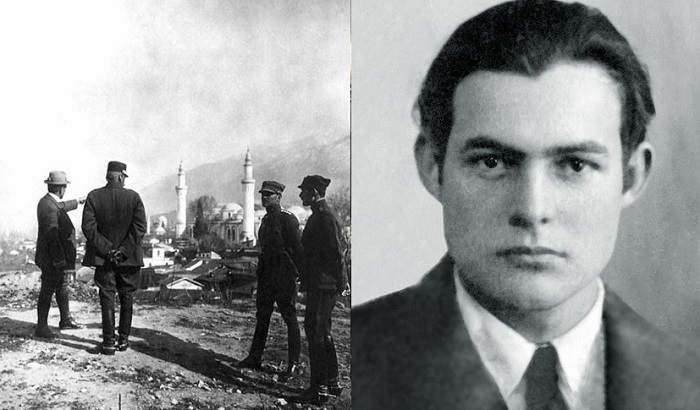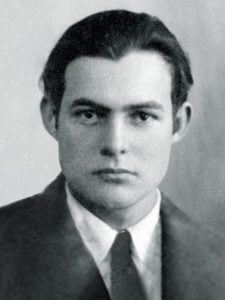
As a young journalist, Ernest Hemingway witnessed first hand the displacement of the Greek population from their ancestral homelands in Pontus, Thrace, and Asia Minor.
His restless spirit of adventure took him to many places, where he so often received the inspiration to write his timeless books. He went to Spain during their civil war, lived in Paris, and spent time in Cuba.
However, early on in his adult life, he spent two years in Constantinople and was introduced to Greek culture during a tragic time for Hellenism.
Little is known about the writer’s beginnings as a journalist and his writings on the war between Greece and Turkey, which took place between 1920 to 1922. Hemingway was only 23 years of age when, on September 30, 1922, he arrived in Constantinople as a war correspondent to cover the Greco-Turkish War for the Toronto Star.
The story titled “Hemingway in Constantinople: Ernest Hemingway’s writings on the Greco-Turkish War in 1922” in The Midwest Quarterly academic journal, written by Peter Lecouras is quite enlightening about the writer’s first contact with Greek culture. The academic article was published on September 22, 2001.
Hemingway in Constantinople

The American legend wrote a total of twenty pieces during his time in Constantinople, beginning with the story “British Can Save Constantinople,” dated September 30, 1922, to his last article, “Refugees from Thrace,” which bore the dateline of November 14, 1922.
During those two years, Hemingway wrote about the war and its politics while at the same time honing the style that would make him a renowned writer. His experiences there inevitably made their way into his later works, as well. The Greco-Turkish war, for instance, is referenced memorably in “The Snows of Kilimanjaro,” written in 1936.
According to Lecouras, Hemingway sympathized with the half-million Thracians who were displaced in the Greco-Turkish War for the political and economic interests of the superpowers of the time— namely Britain, France, and Italy.
In his articles, Hemingway also blames the political decisions of the Greek leadership for the catastrophic results of the war. Following the line of the British foreign office and the American consulate in Ankara, he condemns the Greek cause and the decision of King Constantine to replace competent officers in the Greek army with his cronies.
Describing Greek exodus from eastern Thrace
In “Refugees from Thrace,” Hemingway observes that Greeks leaving Eastern Thrace were fleeing the Turks. He describes with great sympathy the Greek peasants who marched without knowing where they were going, knowing only that they were to flee to save their lives.
The short story “On the Quai at Smyrna,” also inspired by the time the writer spent in Constantinople, is a harrowing work about the dreadful events of 1922. Hemingway describes with painful realism how Smyrna was burned by marauding Turkish soldiers and civilians.
He goes on to tell the sickening story of the slaughtering of 125,000 Greeks there, and how those who survived the brutality of the Turks sought escape on the quay at Smyrna where British warships hovered close by.
Hemingway and the Greek restaurant in Chicago
A story about Hemingway appeared in the November 1979 Princeton Alumni Weekly journal called “Friends for Life: An Alum’s Recollections of Hemingway,” written by William Horne, Jr..
As all Hemingway aficionados know, Ernest Hemingway volunteered to serve his country as a driver in World War I. William Horne likewise felt that he needed to do something for the cause, and in New York, the two young men boarded the same ship that would take them to Bordeaux, France.
Hemingway and Horne met at the Austrian-Italian border, transporting wounded soldiers and running supply lines. This was the beginning of a very long friendship between the men.
Following the war, Horne moved to Chicago, where he worked selling axles in the automotive industry. He then told Hemingway that he would support him financially as a writer because he believed in his talent. Horne recalls in the “Friends for Life” story:
“We rented a fourth-floor room in a house at 1230 N. State Street. It was the kind with a washstand in the corner and a bath down the hall. Meals weren’t included, so we usually ate at Kitso’s, a Greek restaurant on Division Street.”
He further writes that: “It was a quick lunch place with tables, a counter, and a hole in the wall for shouting orders into the kitchen. They served pretty good dinners for 65 or 70 cents, and I think Kitso’s was the scene of Ernie’s story, ‘The Killers.'”
The Greek diner, one of the many businesses in the Windy City run by members of the sizable Greek community, was actually mentioned by Hemingway as the place in which he wrote “The Killers.” The writer himself said he wrote the entire story in a burst of creativity on May 16, 1926, before he ate his lunch at a neighborhood restaurant.
The story is about two professional killers who go to a small town to kill a famous former boxer. It was initially published in March 1927 in Scribner’s Magazine, and Hemingway received $200 for it—a rather princely sum at the time for a struggling writer.
See all the latest news from Greece and the world at Greekreporter.com. Contact our newsroom to report an update or send your story, photos and videos. Follow GR on Google News and subscribe here to our daily email!



